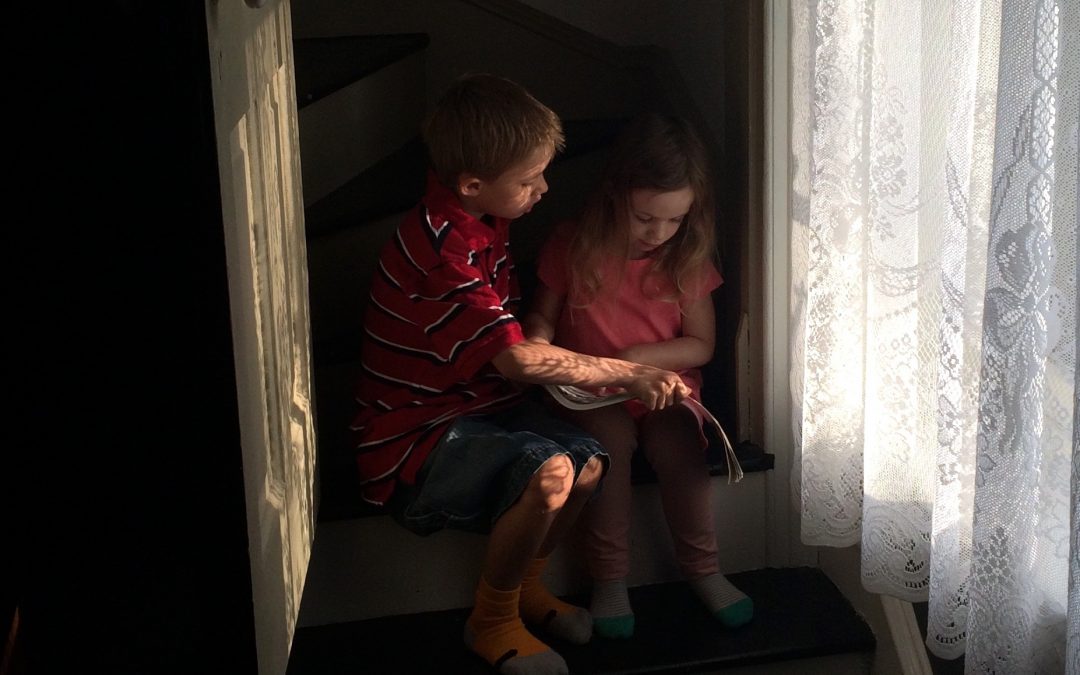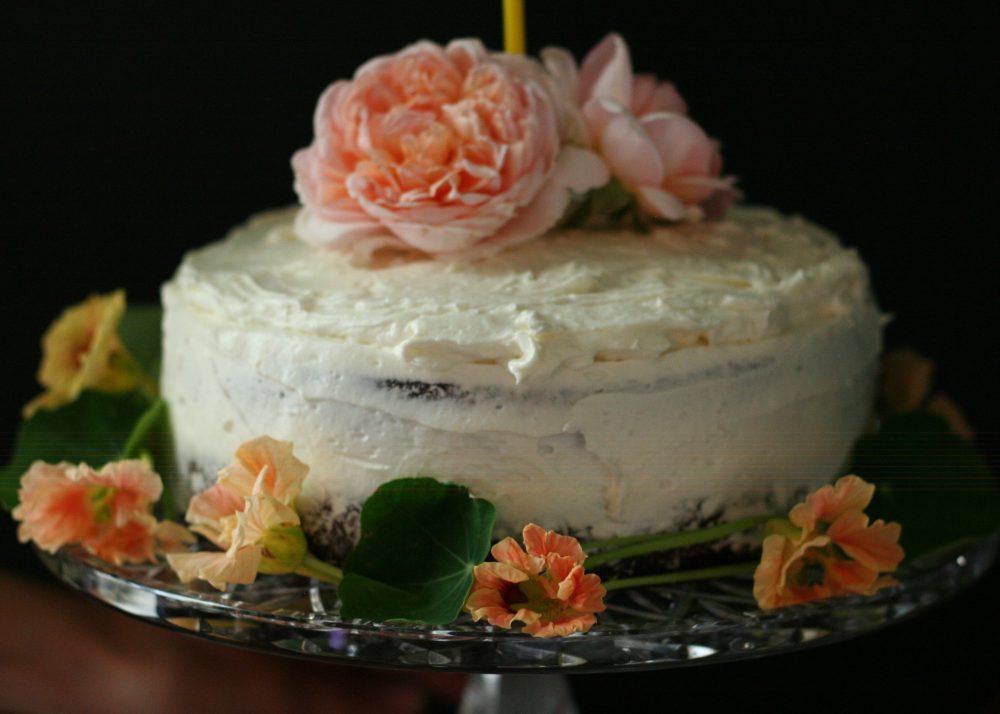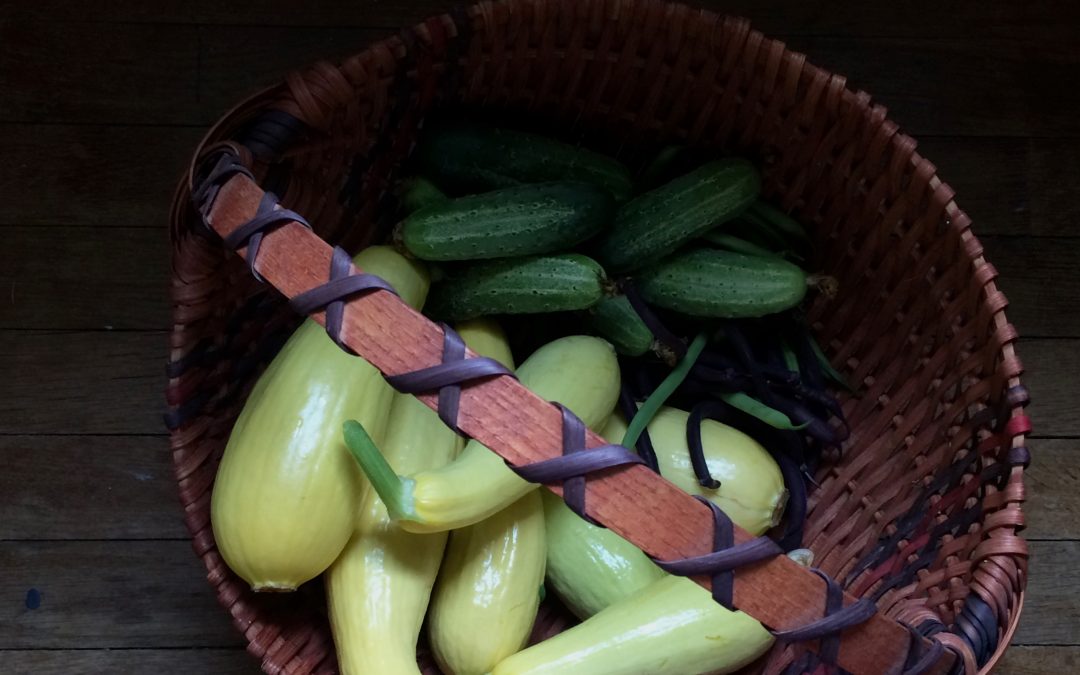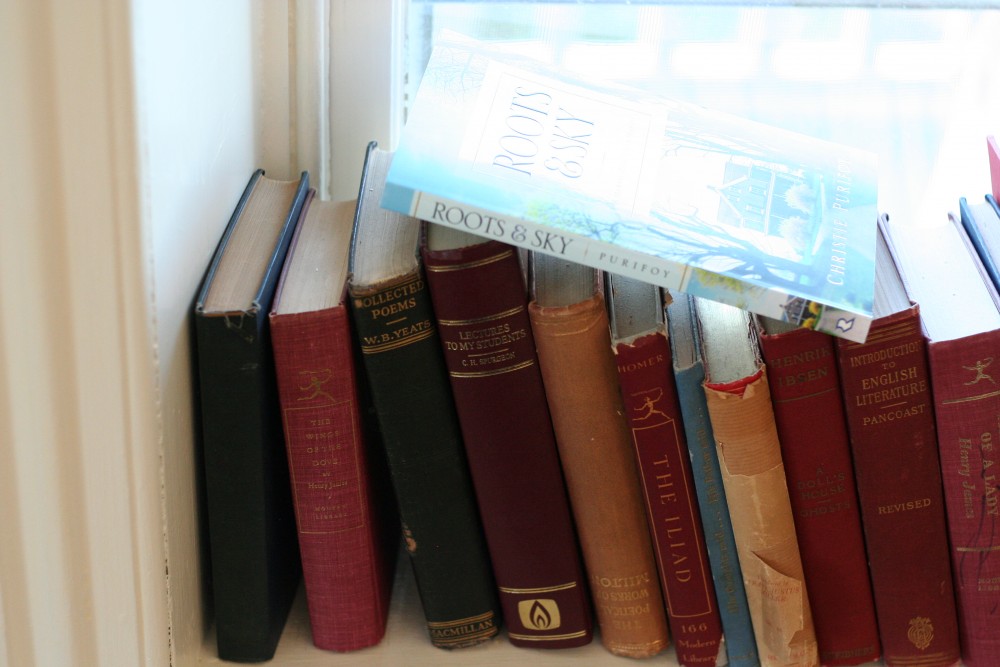
by Christie Purifoy | Nov 23, 2016 | Advent, Books, children, Christmas, Family, Grace Table, Roots and Sky, Seasons, These Farmhouse Bookshelves, Uncategorized, Winter

Ready or not the seasons are shifting.
Of course, we know in our heads that all time moves at the same speed, but our hearts simply will go on beating to some other, more mysterious, rhythm.
Sometimes the gap between those two experiences of time feels like a chasm. We stand on the edge, our hearts out of sync with the calendar, and we fear we will tumble, head over heels, into emptiness. But there are other days. Like Advent days. Then the gap between head-time and heart-time becomes a sacred place and a welcome retreat.
In the last November chapter of Roots and Sky, I wrote this:
I believe in sacred time. We may live in a world of Sunday-morning soccer games, Sunday-afternoon birthday parties, and twenty-four-hour shopping, but I believe there are days when eternity floods our time-bound existence. Days like a cup that runneth over. I also know that without some effort on my part, all time tends to look exactly the same, whether or not it is the same. Advent is beginning, and I want to set aside the days. To mark them off and probe their depths.
The primary way I do that, alone and together with my husband and children, is through books. If you have followed this blog for any length of time, you know that my archives are full of book recommendations for Advent and Christmas. I recently updated the page ( These Farmhouse Bookshelves) where you can explore all those links.
However, with Advent beginning on Sunday, and the first of December only days away, I thought a little roundup was in order. Here are several new-to-me titles and a shelf-full of old favorites.
And, for those of you who can’t think of Advent until after you’ve eaten your Thanksgiving turkey, here is my latest post at Grace Table. It’s a reflection on grief and gratitude and includes a recipe for the prettiest dish I placed on my holiday table last year. Enjoy!
*
My friend Kris Camealy has just published a beautiful new Advent devotional, Come, Lord Jesus: The Weight of Waiting. I read an advance copy months ago, but I am looking forward to reading it again, more slowly and prayerfully, through the month of December.
I have forgotten now who recommended to me Light Upon Light: A Literary Guide to Prayer for Advent, Christmas, and Epiphany by Sarah Arthur. I’ve only skimmed the pages, but these words from the book jacket have me eager to dive in: “Readers are invited to experience Advent, Christmas, and Epiphany in its raw strangeness, stripped of sentiment ….” Those words remind me of Madeleine L’Engle’s description of Advent as The Irrational Season (another favorite book for this season).
Two devotionals I have always appreciated in the past are God With Us: Rediscovering the Meaning of Christmas from Paraclete Press and Watch for the Light: Readings for Advent and Christmas, a collection that includes selections from Dietrich Bonhoeffer, Annie Dillard, C.S. Lewis, and many others
During Advent, we aim to light the candles in our Advent wreath and read a special devotional each evening together. I say aim because, of course, there are nights when I call the whole thing off because all four of the kids insist on fighting over the candle snuffer. I have also learned (the hard way) not to expect my children to sit still for nightly readings without also giving them freshly-sharpened colored pencils and a Christmas coloring book like the Christmas Around the World Coloring Book by Dover.
Unwrapping the Greatest Gift: A Family Celebration of Christmas by Ann Voskamp has been a great companion to our Jesse Tree, but it would make an ideal daily devotional for a family even if you do not decorate a Jesse Tree. This is a substantial book with gorgeous illustrations. The language is rich and poetic enough to capture the attention of my older kids, but the readings are brief and linked to familiar Bible stories, so it works for younger children, too. If you only have very young children, I recommend using The Jesus Storybook Bible for your Advent devotions. There are exactly twenty-four stories from the beginning through to the wise men visiting the infant Jesus, making it perfect for introducing small children to the bigger story of Jesus’s birth during the month of December.
For years, I gave my children a new Advent or Christmas-themed picture book each Sunday of Advent. We now have an impressive collection, though I picked up most of the books during the year for twenty-five cents at a local thrift store. This does mean that our collection is less, well, curated than I might like. But a picture book we all love this time of year is Astrid Lindgren’s Christmas in Noisy Village. This is a delightfully simple description of Christmas celebrations on three Swedish farms packed with young children.
Last year, we read a strange little novel called The Christmas Mystery by Jostein Gaarder. You may know Sophie’s World, also written by this former professor of philosophy from Norway. Some of the strangeness may come from Gaarder’s philosophical bent, and some of it may simply be the little things that can be lost in translation, but the result is a curious, compelling Advent mystery that my kids and I both loved. The story follows the opening of a magical Advent calendar, and so it is already divided into chapters readymade for daily Advent reading. The central mystery involves a journey back through history to the very day and place of the Christ Child’s birth. It reads like following a thread back to that particular momentous day, and the result is that I felt much more solidly connected to the very first Christmas as an actual historical event.
This year, our readaloud chapter book is Winterfrost by Michelle Houts. We are one chapter in, and the kids are already hooked by this tale of Christmas magic on an isolated Danish farm.
Though our seasonal books have spilled over from shelves to piles on the windowsills, I have added one more new book to our Advent collection this year. It is Advent in Narnia: Reflections for the Season by Heidi Haverkamp. Designed for small group discussion, I think this one will also work well for families, especially if you plan to read it alongside The Lion, the Witch, and the Wardrobe.
I’d love to hear about your own favorite Advent and Christmas books in the comments.

by Christie Purifoy | Oct 3, 2016 | Books, Family, Food, Grace Table, Simplicity, These Farmhouse Bookshelves, Uncategorized

(this post contains affiliate links)
September began with a back-to-school, double-birthday, two-nights-in-hospital swirl.
Our only option, once we had emerged on the other side of all that, was to slow time down. Way down.
How does one do that, you ask?
By wasting it, of course.
Stop rushing. Sit still. Stare out of a nearby window.
Take a nap. Putter in the kitchen. Read a book. And then another one.
Procrastinate. Yes, even that.
I am not suggesting you ignore your deadlines and abandon your obligations. But if a task might take two days, and you have three, then wait.
Delay is risky. You may find you don’t have quite as much time for work as you’d like. But there is risk in productivity, too. You might discover you have accomplished so much in a day that the day has gone by in a blur.
I can think of few things more tragic than a lifetime of blurry days.
For the past two weeks, I have wasted time like a professional. I have even broken my unspoken rule and actually read a novel in the morning. Shocking, I know. But when the novel is by Barbara Pym I can hardly help myself.
Pym was a twentieth-century Jane Austen. There is less conventional romance in her novels of a post-war Britain, there is certainly more melancholy, but there is the same keenly observant eye and witty sense of humor. So far I have read Excellent Women (1952) and Quartet in Autumn (1977), and I highly recommend them both. The first is more humorous, the second more preoccupied with sorrow, but both are quietly subversive and fiercely intelligent.
When not reading, I have been cooking. I’m not baking bread or making party appetizers, I am only making dinner. These quieter, slower days have reminded me that family dinner is not the onerous obligation I have sometimes believed it to be. Instead, it is a delicious, daily treat.
Of course, if I wait until five pm to give it my attention, then it can be stressful. But why should I wait? Why not sip my morning coffee while asking what’s for dinner? Surely there are few questions so full with pleasurable possibility.
This is especially true if you own one of my favorite family cookbooks Dinner: A Love Story. Jenny Rosenstrach’s recipes are straightforward, wholesome, and tasty, and her celebration of the family dinner hour (written from the perspective of a busy, full-time working mother, no less) has been just the inspiration I needed to try new recipes.
And, I can’t wait to try her just-released cookbook How To Celebrate Everything.
I recently finished Katherine Willis Pershey’s wonderful new book Very Married: Field Notes on Love and Fidelity. You can find my full review on Goodreads, but here is the condensed version: Very Married is my favorite book on marriage. The personal storytelling is funny and friendly, but it is also inspiring and wise.
This book (with a foreword by Eugene Peterson!) is also that incredibly rare thing in Christian publishing: a book for all of us. No matter how your own views line up with Christian teaching on marriage, Pershey’s book is for you. Whether you consider yourself liberal or conservative, Very Married is for you. Pershey doesn’t ignore controversial or complex topics, and she doesn’t hesitate to state her own positions, but she writes with such grace and compassion. Her book reminded me not only how beautiful fidelity can be, but how beautiful Christian unity can be.
If slowing down holds appeal for you, I have one more recommendation. My dear friend Summer Gross, an ordained minister and spiritual director, has recently inaugurated a “Slow Word Movement.”
Summer offers guided Scripture meditations, or Lectio Divina, via video through her website. You can sign up to receive each new “Slow Word” in your email inbox. Summer has made it so easy for us to hit pause in order to find that still point in our spinning world. I hope you’ll visit her website to find out more and subscribe.
Finally, here is my latest post for Grace Table. It includes a recipe for our new favorite cake.
What are you reading and cooking these days?

by Christie Purifoy | Aug 16, 2016 | Books, Food, Gardening, God's Love, Religion, These Farmhouse Bookshelves, Uncategorized
(this post contains affiliate links)

I moved to this old farmhouse with dreams of a garden, but it wasn’t a flower garden. What an extravagant dream that would have been. I was a garden do-gooder. If you had asked me to place a spiritual value on a box of seed packets, tomatoes for canning and cucumbers for pickling would have risen right to the top. Morning glories were an indulgence.
Extravagance is something I have had to learn.
Jesus told us he came to give us life. But not just enough life to scrape by. Not a pinched and narrow life. Life to the full. Abundant life. Life like a cup overflowing.
Life like a garden bursting with flowers.
There is a ministry of flowers. I don’t think I can yet claim it as my own. If I practice it, it is only in small ways. A bouquet for a neighbor here. A flower photo on instagram there.
These days, the ministry of flowers is God’s ministry to me. The flowers that grow here at Maplehurst have become an emblem of God’s wild love and evidence of his generative presence on this earth. They are extravagant. Foolish in their ephemeral beauty. Profuse and profligate and anything but practical.
But this is a post about books.
And it is a post about the ministry of cake.
D. L. Mayfield is one of my favorite online writers. Her first book comes out today, and it is a gorgeous, heartbreaking, and wise collection of personal essays.


Assimilate Or Go Home shows us how Mayfield’s own do-gooder dream deflated, not in the garden but on the mission field. In her own words:
The more I failed to communicate the love of God to my refugee friends, the more I experienced it for myself. The more overwhelmed I felt as I became involved in the myriads of problems facing my friends who experience poverty in America, the less pressure I felt to attain success or wealth or prestige. And the more my world started to expand at the edges of my periphery, the more it became clear that life was more beautiful and more terrible than I had been told.
There are so many reasons to read this book, but I especially recommend it for Mayfield’s final reflections on the ministry of cake. Cake, like flowers, seems like a nonessential. In a world rocked by wars and rumors of wars, in a world of unbearable sorrows and grief, a world where too many people lack even basic necessities, what is the point of cake? I am reminded of Marie Antoinette. If we celebrate flowers or cake, if we celebrate at all, are we hopelessly out of touch? Extravagant to the point of selfishness?
Sometimes we must receive something in order to understand that it is worth giving. Because God gave me flowers, I tend those flowers and I give them away knowing that they matter. Mayfield wanted to give her refugee friends everything: answers, solutions, even the love of God, but they gave her cake and that changed everything.
Her most of all.
Here are two more book recommendations (one for cake and one for flowers). Perhaps they might help you to receive the love of God in more beautiful and more delicious ways.


This is my new favorite cookbook. It’s a book of seasonal desserts inspired by homegrown produce and farmer’s market bounty. As soon as I opened it, I wanted to bake my way from first page to last.
The banana and summer squash cake is my children’s new favorite cake. Seriously. Also, there is a cake recipe inspired by those apple cider doughnuts so beloved at Amish farmstands and pick-your-own apple orchards. Need I say more?


This beautiful book was a birthday gift to me from my sister Kelli. It is pretty and inspiring, but it’s also informative and practical. I still have so much to learn about floral design (okay, I still have everything to learn), but I’ve already implemented a few good tips and ideas from this book. Because the bouquet we take to a neighbor, and the flowers we arrange for our own bedside table, matter more than we know.
Tell me, what books are on your nightstand?

by Christie Purifoy | Jul 9, 2016 | Art, Books, Chicago, Grace Table, peace, Pennsylvania, These Farmhouse Bookshelves, Uncategorized
(an installment in my occasional series of book recommendations; this post contains affiliate links)

These are violent days. What good are books? Of what use is poetry?
In his elegy for W. B. Yeats, the poet W. H. Auden famously wrote, “poetry makes nothing happen.” Yet the poem itself complicates this view.
Poetry may or may not change a thing, but if we feel compelled to sing, why not sing, as Mary once sang, of justice?
If we feel compelled to read, why not shed the burden of our own particular skin and view the world through another’s eyes? For a little while?
Here is a poem for that.
Here is one more.
*
A favorite book on our family shelves is Brown Girl Dreaming, a recent Newbery Honor Book by Jacqueline Woodson. My twelve-year-old daughter and I both loved it. The poetry is accessible but incredibly rich.
In a similar vein, I recommend Inside Out and Back Again, by Thanhha Lai. Written in verse, this story communicates difficult truths and complicated historical experiences with grace and lyricism. It is one of the sweetest, saddest, loveliest books I have read.
When I was a new graduate student living on the south side of Chicago, I first read the classic 1952 novel Invisible Man by Ralph Ellison. That was years ago, and I don’t remember the book very well. What I do remember is the shock I felt reading a novel told from the perspective of a nameless black man. For the first time in my life I recognized how the skin we walk around in can remake the world around us. I had never even imagined a world like the one inhabited by this invisible man, but there it was, and while I read the book, I lived in it.
*
Like most summers, this one is too loud, too crowded, too hot. But, as I write in Roots and Sky, this cuts two ways. There are also too many lilies in the garden and too many squash on the vine. My way of dealing with the too-muchness of it all is what I call “comfort-reading.” This means I am finding most of my reading material on the shelf at my local Goodwill thrift store: fifty cent Agatha Christie paperbacks, an old Martha Stewart gardening book without its carefully photographed jacket, an Englishman’s memoir of life in Provence that must have been on everyone’s beach-read list the summer of ’89.
I revisited the Goodwill bookshelves only yesterday and found two treasures. The first was a copy of The Taize Picture Bible: Stories From the Scriptures in almost perfect, vintage condition. I have heard such good things about this illustrated Bible for children over the years, but it has long been out of print. I paid $1.97 and couldn’t believe my luck.
The second was a pristine paperback copy of Elizabeth Enright’s Thimble Summer, the winner of the 1939 Newbery Medal. I didn’t buy it only because I recently found a vintage hardback of the same title at my local used bookstore. It has been our evening family read-aloud for a week now.
My ongoing quest to discover read-aloud books all four of my kids will submit to listening to (actually enjoying the book is a higher standard; I am satisfied if two of four children say they “like” the book) has recently met with failure upon failure. The last success I remember is Laura Ingalls Wilder’s Farmer Boy, a book that has a lot in common with Thimble Summer.
*
On the recommendation of a friend, I recently began reading The Manor: Three Centuries at a Slave Plantation on Long Island. After my friend explained it was a book about an old house written by a landscape historian, she said, “I think you’ll like it.” I said, “I think you’re right.”
More factual and straightforward than a historical novel, yet much more readable and compelling than a history textbook, The Manor tells the story of one of the first great European houses in North America, and the family who lived in it and preserved its history for centuries. One house might not seem so important, but the door of this house opens up a story of northern slavery that has since been either forgotten or willfully ignored.
The first Sylvesters were Quakers, and the story of their lives is revising a story I have always taken pride in. My own farmhouse was built by Quakers, and I have long given credit for the beauty of this part of Pennsylvania to the generations of residents who have sown peace and justice into the very soil of this place. That story is still true, but The Manor tells an older, darker tale. According to this story, the blood of enslaved Africans touches every aspect of our earliest history and every one of my seemingly peaceful, green hills.
*
Seeds of brutality and injustice were sown into our country’s soil from its earliest days. It is a small thing to know that the atrocities of slavery on sugar plantations in Barbados could not have been sustained without the animals and crops raised on New England farms, yet somehow that knowledge has brought the shame of slavery home to my own heart.
Those Barbadian plantation owners lived in homes built like fortresses. They exploited, in fact, they brutalized their workers and so they feared them.
Slavery is long gone, but we still reap that terrible harvest. We worship safety. We are afraid of black men, but it is the black men, and their communities, who pay the price for our fear.
When I hear that one more police officer has killed one more black man, I cannot throw a stone at that officer. I remember how, years ago, fear would rise up in me if I followed the sidewalk beneath a graffiti-splattered viaduct and saw a young black man in baggy pants approaching from the other direction. It took years of living in that south-side Chicago neighborhood to learn that I was always so much safer than any of those young black men. In ten years, I was never the victim of a crime, but neighbor after neighbor, innocent after innocent, male and female but always black-skinned, died of gun violence while I lived, untouched, in their midst.
Separation breeds fear, and fear breeds violence.
But if violence is a failure of the imagination, as the poet William Stafford said, then perhaps poetry can make something happen?
Comfort-reading has its place, but I must also read to bring dark things into the light. Especially, those dark things in my own self.
What if we tuned our imaginations to the songs of others not like ourselves?
If poetry makes beauty and creates hope, can it also help us to act justly and love mercy?
Can it help us walk humbly with our God?
*
With these questions in mind, do you have any book recommendations for me?
If you are looking for a quick Saturday read, here is my latest post for Grace Table: “What Hospitality Looks Like In A Castle.”

by Christie Purifoy | Apr 9, 2016 | Books, Grace Table, Roots and Sky, These Farmhouse Bookshelves, Uncategorized

It has been too windy and cold since Easter for much gardening. Asparagus crowns, strawberry plants, and a net sack of seed potatoes are all waiting, more patiently than I am, to be planted out. If April showers bring May flowers, then I am hoping April hail and snow really do the trick.
While the storms rage, I read up a storm indoors.


You Are What You Love: The Spiritual Power of Habit is a new release by James K. A. Smith. I don’t tend to pick up books on Christian discipleship and spiritual formation, or, if I do, my attention wanders well before I’ve turned the final page. Though I haven’t quite finished this one, I’ve begun deliberately slowing my pace. I’m already certain I’ll be reading this a second time and passing it on.
Smith’s argument is at once self-evident and astonishing. It brings into sharp focus so many of the dynamics of my own spiritual journey.
Descartes said, “I think, therefore I am,” but most of us know, intuitively, that isn’t so. What we think touches only a small, small part of our lives. Love, desire, and worship are much more powerful forces in our lives, and we will never be transformed if we limit Christian discipleship to what we think about doctrine or articles of faith.
The difficult but ultimately beautiful truth explored in this book is that we do not always love who and what we think we love.


I read the first installment in the Duncan Kinkaid/ Gemma James mystery series, A Share in Death, a long time ago and promptly forgot about it. I enjoyed the story, but I forgot that what I appreciate most in a mystery series is the slow and subtle revelation of the central characters. This means that if I think a series has potential, I should read them in order and read at least the first two or three. I am so glad I recently picked up book two All Shall Be Well.
I don’t like the look of mass market paperbacks (perhaps because they all look the same to me?), but, despite appearances, this is a great series for fans of Louise Penny. Scotland Yard detective Duncan Kinkaid interviews suspects in a London of stewed tea and curry takeaways while Inspector Gamache enjoys tender baguettes in a quaint Quebec village, but I think they have a lot in common. These books are a great way to pass the time until Penny’s newest book comes out in August.
Next week I’ll be participating in the Festival of Faith and Writing at Calvin College in Michigan. I’ll be speaking on a panel with Preston Yancey (I’ve heard his latest book Out of the House of Bread is wonderful, and I’ll be reading it myself soon), Addie Zierman (I told you how much I enjoyed her latest memoir, Night Driving), and another wonderful writer Sarah Bessey (her latest is Out of Sorts: Making Peace With An Evolving Faith).
I’m looking forward to hearing from some of my favorite writers, including Christian Wiman, Leslie Leyland Fields, Luci Shaw, and George Saunders.
I met blogger Anne Bogel at the last Festival of Faith and Writing. If you are looking for a new book to read, I highly recommend her podcast What Should I Read Next? In each episode, Anne talks with a thoughtful reader about three books they love and one book they hate. Based on those titles, she recommends three books to try. I almost always learn about some new-to-me title, and it was a conversation on this podcast that reminded me I’d abandoned the Duncan Kinkaid/Gemma James series too quickly.
After a brief hiatus, the Roots and Sky book club is back. Laura Brown asks such thoughtful questions. I hope you’ll check it out, either by offering your own comment or “listening” in. As a bonus, you’ll find several audio recordings of me reading from the book.
I recently shared a Roots and Sky-themed installment of “These Farmhouse Bookshelves” on writer Rachel McMillan’s website.
I have a new piece called “Comfort Food For Those Who Mourn” at Grace Table. It includes a recipe for my family’s favorite dessert.
Do you have a favorite comfort food?

by Christie Purifoy | Feb 27, 2016 | Books, Family, Food, grief, Roots and Sky, These Farmhouse Bookshelves, Uncategorized, Winter

The record of post drafts here on my blog dashboard tells me that on January 14, 2016, I was working on a new installment in my occasional series of book recommendations, These Farmhouse Bookshelves.
I never finished that post, and I didn’t read anything for a month.
I want to finish that post, but I can’t finish it seamlessly. Everything is before and after for us right now, and so much in our lives is sorting itself out around that dividing line. I feel such compassion for our before selves. They are innocent and unseeing, and it hurts to think of all that they didn’t yet know.
Still, if I could go to them and give them some message it wouldn’t be anything earth shattering or even all that original. It would be only the well-known words from Frederick Buechner:
“Here is the world. Beautiful and terrible things will happen. Don’t be afraid.”
When I began this post, my before self was still waiting for snow to fall at Maplehurst. This has been the mildest and strangest winter anyone around here can remember. Three feet of snow fell while I was with family in Hawaii, but now I have seen the tops of the daffodils emerging a full month early.
With no snow outside, Elsa and I enjoyed Snow by Cynthia Rylant. Actually, I may have read it to myself a few times after Elsa fled my lap. It’s that good.
by Cynthia Rylant. Actually, I may have read it to myself a few times after Elsa fled my lap. It’s that good.
It captures everything I love about snow and hits that perfect blend of truth, poetry, and accessibility. I am often frustrated with the more self-consciously beautiful or poetic picture books because they aren’t concrete enough to grab my child’s attention.
If you’ve ever read a book to a three-year-old you know they can’t hear the line “the snow looks like ice cream” without interrupting, “Where’s the ice cream? Where, where?”
Poetry that doesn’t rely only on direct metaphors is a great thing in a picture book. Is the best snow the snow that comes in the night or the snow that sends you home from school? There is poetry in that question even a three-year-old can understand.
*
My before self had also begun reading a great new book called To the Table: A Spirituality of Food, Farming, and Community by Lisa Graham McMinn.
by Lisa Graham McMinn.
A book about “eating with more intention, compassion, and gratitude,” I would recommend this book to everyone who enjoys Michael Pollan’s Cooked: A Natural History of Transformation , Barbara Kingsolver’s Animal, Vegetable, Miracle: A Year of Food Life
, Barbara Kingsolver’s Animal, Vegetable, Miracle: A Year of Food Life , or Fred Bahnson’s Soil and Sacrament: A Spiritual Memoir of Food and Faith
, or Fred Bahnson’s Soil and Sacrament: A Spiritual Memoir of Food and Faith .
.
The illustrations and recipes that accompany each chapter are delightful and there are discussion questions that would make this book perfect for a book club. This book is full of rich spiritual wisdom and well-researched information, but it is a lot of fun to read, too.
*
A year and a half ago, I wrote a blog post about family and friendship.
I had just returned from a reunion with my parents, siblings, and our (many) children at my parent’s home in Kansas City. I wrote about how hard it is to live far from family and to see them so infrequently. I wrote about that emptiness, and I wrote about the special ways God fills that emptiness.
Now my after self knows that was the last time I would see my brother-in-law Shawn. Soon after that visit, my sister and her family moved to Hawaii.
Of course, that small blog post means so much more to me now, but I might not even have remembered it if a book had not been waiting for me when I returned home from Hawaii.
The Gift of Friendship: Stories That Celebrate the Beauty of Shared Moments, edited by writer and photographer Dawn Camp, is a collection of reflections by Christian bloggers. Dawn has gathered meditations on friendship by bloggers like Lisa-Jo Baker, Tsh Oxenreider, Jennifer Dukes Lee, and many others.
My post is there, too.
And I have yet one more reason to believe that though the future is, mercifully, hidden from us, it is never hidden from God.
*
You are each invited to an online book club for my book Roots and Sky: A Journey Home in Four Seasons.
Hosted by writer and editor extraordinaire, Laura Brown of the website Makes You Mom, the discussions will take place each Wednesday during the month of March.
Makes You Mom is a literary website that celebrates motherhood and welcomes anyone whose life has been shaped by a mom.
I will show up occasionally to answer questions, but I will not listen in or interfere in the discussion. Laura and I want everyone who participates to feel free to ask their hardest questions.
You can find more information about the book club here.



















